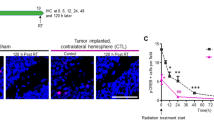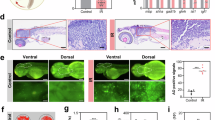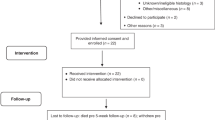Abstract
Study design
Experimental study.
Objectives
To evaluate the efficacy of Angiotensin-converting enzyme inhibitor Ramipril, as a mitigator of radiation-induced spinal cord injury.
Setting
Stony Brook University, Stony Brook, NY, USA.
Methods
Total of 22 rats were irradiated with single doses of 23.6–33 Gy at the C4-T2 spinal levels. After irradiation, the rats were randomized to the radiation only control group and the Ramipril-treated (radiation + Ramipril) experimental group. Ramipril 1.5 mg/kg/day was given in the drinking water starting 1 week after radiation through the study duration.
Results
All the rats irradiated with 28.5–33 Gy became paralyzed at 125 ± 4 days, whereas no rats became paralyzed after 23.6 Gy. The time to develop paralysis was delayed to 135 ± 4 days in Ramipril-treated group (P < 0.001). H&E and LFB showed microscopic structural restoration and remyelination with Ramipril treatment. VEGF expression was increased in the irradiated spinal cord, and the number of VEGF-positive cells was significantly decreased by Ramipril treatment (P < 0.001). Immunohistochemical stain with Iba-1 showed increased microglial infiltration in the irradiated spinal cords. The number of Iba-1-positive microglia was significantly reduced by Ramipril treatment (P < 0.05).
Conclusion
Ramipril reduced the rate of paralysis even at the paralysis-inducing radiation doses. It also significantly delayed the onset of paralysis. Neuroinflammation and endothelial cell damage may be the key mediators of radiation injury. Ramipril can be readily translatable to clinical application as a mitigatory of radiotherapeutic toxicity.
Similar content being viewed by others
Log in or create a free account to read this content
Gain free access to this article, as well as selected content from this journal and more on nature.com
or
References
Ryu S, Jin JY, Jin R, Rock J, Ajlouni M, Movsas B, et al. Partial volume tolerance of the spinal cord and complications of single-dose radiosurgery. Cancer. 2007;109:628–36.
Ryu S, Pugh SL, Gerszten PC, Yin FF, Timmerman RD, Hitchcock YJ, et al. RTOG 0631 phase 2/3 study of image guided stereotactic radiosurgery for localized (1-3) spine metastases: phase 2 results. Pract Radiat Oncol. 2014;4:76–81.
Schultheiss TE, Stephens LC. The pathogenesis of radiation myelopathy: widening the circle. Int J Radiat Oncol Biol Phys. 1992;23:1089–91.
Wong CS, Fehlings MG, Sahgal A. Pathobiology of radiation myelopathy and strategies to mitigate injury. Spinal Cord. 2015;53:574–80.
Conner KR, Payne VS, Forbes ME, Robbins ME, Riddle DR. Effects of the AT1 receptor antagonist L-158,809 on microglia and neurogenesis after fractionated whole-brain irradiation. Radiat Res. 2010;173:49–61.
Lee TC, Greene-Schloesser D, Payne V, Diz DI, Hsu FC, Kooshki M, et al. Chronic administration of the angiotensin-converting enzyme inhibitor, ramipril, prevents fractionated whole-brain irradiation-induced perirhinal cortex-dependent cognitive impairment. Radiat Res. 2012;178:46–56.
Moulder JE, Cohen EP, Fish BL. Mitigation of experimental radiation nephropathy by renin-equivalent doses of angiotensin converting enzyme inhibitors. Int J Radiat Biol. 2014;90:762–8.
Kim JH, Brown SL, Kolozsvary A, Jenrow KA, Ryu S, Rosenblum ML, et al. Modification of radiation injury by ramipril, inhibitor of angiotensin-converting enzyme, on optic neuropathy in the rat. Radiat Res. 2004;161:137–42.
Ryu S, Kolozsvary A, Jenrow KA, Brown SL, Kim JH. Mitigation of radiation-induced optic neuropathy in rats by ACE inhibitor ramipril: importance of ramipril dose and treatment time. J Neurooncol. 2007;82:119–24.
Robbins ME, Zhao W, Garcia-Espinosa MA, Diz DI. Renin-angiotensin system blockers and modulation of radiation-induced brain injury. Curr Drug Targets. 2010;11:1413–22.
Acharya MM, Green KN, Allen BD, Najafi AR, Syage A, Minasyan H, et al. Elimination of microglia improves cognitive function following cranial irradiation. Sci Rep. 2016;6:31545.
Nordstrom M, Abrahamsson T, Ervik M, Forshult E, Regardh CG. Central nervous and systemic kinetics of ramipril and ramiprilat in the conscious dog. J Pharmacol Exp Ther. 1993;266:147–52.
Abercrombie M. Estimation of nuclear population from microtome sections. Anat Rec. 1946;94:239–47.
Bijl HP, van Luijk P, Coppes RP, Schippers JM, Konings AW, van der Kogel AJ. Dose-volume effects in the rat cervical spinal cord after proton irradiation. Int J Radiat Oncol Biol Phys. 2002;52:205–11.
Medin PM, Foster RD, van der Kogel AJ, Sayre JW, McBride WH, Solberg TD. Spinal cord tolerance to single-fraction partial-volume irradiation: a swine model. Int J Radiat Oncol Biol Phys. 2011;79:226–32.
Molteni A, Moulder JE, Cohen EF, Ward WF, Fish BL, Taylor JM, et al. Control of radiation-induced pneumopathy and lung fibrosis by angiotensin-converting enzyme inhibitors and an angiotensin II type 1 receptor blocker. Int J Radiat Biol. 2000;76:523–32.
Kohl RR, Kolozsvary A, Brown SL, Zhu G, Kim JH. Differential radiation effect in tumor and normal tissue after treatment with ramipril, an angiotensin-converting enzyme inhibitor. Radiat Res. 2007;168:440–5.
Robbins ME, Hopewell JW. Physiological factors effecting renal radiation tolerance: a guide to the treatment of late effects. Br J Cancer Suppl. 1986;7:265–7.
Alvarez A, Cerda-Nicolas M, Naim Abu Nabah Y, Mata M, Issekutz AC, Panes J, et al. Direct evidence of leukocyte adhesion in arterioles by angiotensin II. Blood. 2004;104:402–8.
Piqueras L, Kubes P, Alvarez A, O’Connor E, Issekutz AC, Esplugues JV, et al. Angiotensin II induces leukocyte-endothelial cell interactions in vivo via AT(1) and AT(2) receptor-mediated P-selectin upregulation. Circulation. 2000;102:2118–23.
Rahman ST, Lauten WB, Khan QA, Navalkar S, Parthasarathy S, Khan BV. Effects of eprosartan versus hydrochlorothiazide on markers of vascular oxidation and inflammation and blood pressure (renin-angiotensin system antagonists, oxidation, and inflammation). Am J Cardiol. 2002;89:686–90.
Benicky J, Sanchez-Lemus E, Honda M, Pang T, Orecna M, Wang J, et al. Angiotensin II AT1 receptor blockade ameliorates brain inflammation. Neuropsychopharmacology. 2011;36:857–70.
Ruiz-Ortega M, Lorenzo O, Ruperez M, Suzuki Y, Egido J. Angiotensin II activates nuclear transcription factor-kappaB in aorta of normal rats and in vascular smooth muscle cells of AT1 knockout mice. Nephrol Dial Transplant. 2001;16:27–33.
Nordal RA, Nagy A, Pintilie M, Wong CS. Hypoxia and hypoxia-inducible factor-1 target genes in central nervous system radiation injury: a role for vascular endothelial growth factor. Clin Cancer Res. 2004;10:3342–53.
Leung DW, Cachianes G, Kuang WJ, Goeddel DV, Ferrara N. Vascular endothelial growth factor is a secreted angiogenic mitogen. Science. 1989;246:1306–9.
Dvorak HF, Brown LF, Detmar M, Dvorak AM. Vascular permeability factor/vascular endothelial growth factor, microvascular hyperpermeability, and angiogenesis. Am J Pathol. 1995;146:1029–39.
Radisavljevic Z, Avraham H, Avraham S. Vascular endothelial growth factor up-regulates ICAM-1 expression via the phosphatidylinositol 3 OH-kinase/AKT/Nitric oxide pathway and modulates migration of brain microvascular endothelial cells. J Biol Chem. 2000;275:20770–4.
Chua CC, Hamdy RC, Chua BH. Upregulation of vascular endothelial growth factor by angiotensin II in rat heart endothelial cells. Biochim Biophys Acta. 1998;1401:187–94.
Wilkinson-Berka JL, Kelly DJ, Gilbert RE. The interaction between the renin-angiotensin system and vascular endothelial growth factor in the pathogenesis of retinal neovascularization in diabetes. J Vasc Res. 2001;38:527–35.
Acknowledgements
The authors acknowledge that the animal irradiation was performed at Henry Ford Hospital (SR before moving to Stony Brook University), thank Andrew Koloszvary, Stephen Brown, Karen Lapanowski for technical help.
Funding
This work was supported by internal funds from Stony Brook University Hospital.
Author contributions
MGC was responsible for the methodology, project administration, software, visualization, writing-original draft and writing-review. AMS was responsible for the formal analysis, investigation, methodology, validation, visualization, writing-original draft and writing-review. SET was responsible for supervision, data interpretation, validation, visualization, writing-original draft and writing-review and editing. SR was responsible for the conceptualization, formal analysis, funding acquisition, investigation, methodology, supervision, validation, visualization, writing-original draft and writing-review and editing.
Author information
Authors and Affiliations
Corresponding author
Ethics declarations
Conflict of interest
The authors declare that they have no conflict of interest.
Rights and permissions
About this article
Cite this article
Clausi, M.G., Stessin, A.M., Tsirka, S.E. et al. Mitigation of radiation myelopathy and reduction of microglial infiltration by Ramipril, ACE inhibitor. Spinal Cord 56, 733–740 (2018). https://doi.org/10.1038/s41393-018-0158-z
Received:
Revised:
Accepted:
Published:
Issue date:
DOI: https://doi.org/10.1038/s41393-018-0158-z



